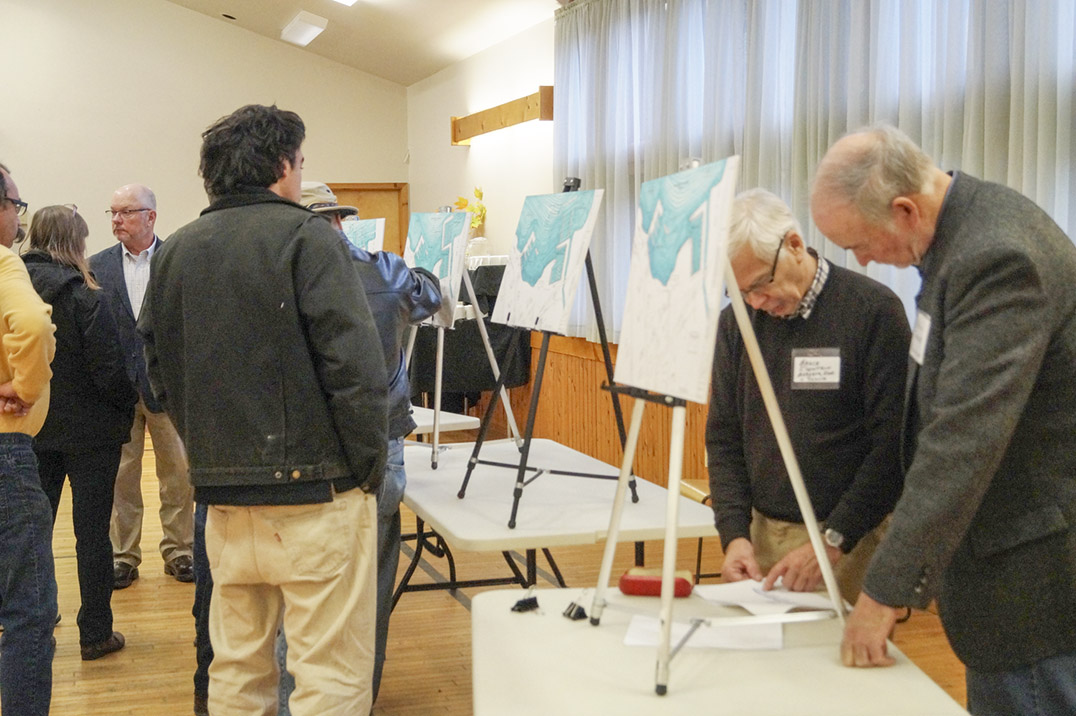KAGAWONG—Approximately 30 interested citizens, along with Billings council and a five-member consulting team, gathered last Wednesday at the Park Centre to provide input before the Kagawong Waterfront Improvement Project draft master plan is approved.
Billings Township developed its last strategic plan for economic development in the mid 1980s. In the 2006-2010 term of council, a list of strategic priorities for development was agreed upon by the council of the day, however, there was no community consultation at that time.
Two community meetings were held in 2010, sponsored by a group of boaters (with the blessing of council) to determine public support for a proposed marina development. When the new council took office in 2010, they confirmed that an overall community planning exercise was desirable and solicited the help of LAMBAC to carry it out.
Under the guidance of LAMBAC staff, council struck the terms of reference for the kind of plan they wanted. They were in agreement that a sustainable community was their long term goal, and thus settled on a Sustainability Plan. Sustainable community development demands a community-based process. The planning exercise they used included many opportunities for community consultation on issues of social, environmental, cultural and spiritual well-being, as well as economic progress.
A stakeholder consultation took place with seven focus groups taking part. With a total of 91 participants, they represented boaters and non boaters alike along with business owners and farmers market vendors among others.
The Sustainability Plan 2012-2017, now in its third year, is right on track. The action strategy included ‘apply for grants and hire a consulting firm to develop an implementation study for the harbour,’ and ‘implement as soon as funding can be obtained.’
Members of the Waterfront Improvement Committee, which includes members of council (including the mayor), led by Chair Tom Imrie, were available to provide information to those who may not have prior background on the proposed plans.
Drawings depicting the present marina, along with Alternate 1 (featuring a grouping of floating docks) and Alternate 2 (featuring a permanent break wall) were on display for public viewing. There was also a pair of waterfront drawings showing Concept A (restaurant and showers as two buildings) and Concept B (restaurant and showers as one building) available for consideration and comment. A sixth and final drawing showing the ‘preferred plans:’ Alternate 1 and Concept A was shown.
When Ray Spangler of C2S Engineering was asked by a concerned resident what type of septic system would be installed, he described a bio-filtration system and potential options for its location.
Rodger Todhunter, who has area roots having been raised in Willisville, is a landscape artist and is responsible for creating boardwalks and landscaping designs for the proposed waterfront improvement proposal.
The drawings, created by Sudbury based firm C2S Engineering, feature a boardwalk that begins at the (existing) Aus Hunt Marina, and winds its way along the ‘improved waterfront,’ past the (CSA approved) playground, connecting it to the small craft harbour.
Tom Hluchan, a marine engineer, took The Expositor on a visual tour through a series of drawings, highlighting the benefits of the consultant’s preferred option for the waterfront improvement project.
Alternate 1 depicts a grouping of floating docks which actually creates fish habitat as they can go underneath it, “taking advantage of the shade they offer.”
Alternate 2 shows a permanent breakwall that would be an extension from the small craft harbour, creating an ‘S’ shaped pattern. This option, stated Mr. Hluchan, is expensive and not eco-friendly.
There are currently 52 slips at the marina. Alternate 1 would add an additional 64 slips for total of 116.
Architect Dennis Castellan of Castellan James and Partners in Sudbury shared that while designing the proposed buildings for the waterfront, they took the size and scale of the buildings, space between them and how to connect the street and water into consideration to enhance the ‘visual experience.’
Bruce Fountain, marketing benefits consultant, stated that whatever plans the Township decides to move forward with “has to make economic sense and not burden the taxpayer.” The character and charm of the village is appreciated by Mr. Fountain and one of his responsibilities is to identify gaps such as a grocery store and seasonal restaurant.
Mr. Fountain feels the Township should be cautious if a decision is made to consider a year round restaurant. Based on a 30 seat dining area, the profit formula is based on $10,000 per seat annually. “It has to make economic sense,” he concluded.
Councillor Imrie shared that the waterfront improvement project is a “phased approach” and may take up to five years to complete. The project, he stated, “is do-able.”
Funding secured by FedNor and Heritage Canada could make the $4.8 million project a reality. The Township would be required to pay 10 percent of the total cost and would be borrowed from the bank and revenue from the marina and other sources used to repay it. Councillor Imrie encourages everyone to adopt the motto “live, work and invest in Kagawong.”
Clerk Treasurer Kathy McDonald echoed Councillor Imrie’s statement, sharing that those who may oppose the project are under the assumption that the money will come from the taxpayers. This, she shared, would not be the case as the township would borrow its portion.
Members of two other Kagawong volunteer groups were on hand to partner with the Township during the afternoon’s open house. Refreshments were provided by the Recreation Committee and for those residents who had not yet picked up their two free recycle bins, they were made available by volunteers of the newly formed Go Green Committee.
When asked what the next step would be, Councillor Imrie stated that the (Waterfront) Committee, along with members of council, would review the comments gathered from the public during the open house and following a two week commentary, take their proposal to the funding parties.



